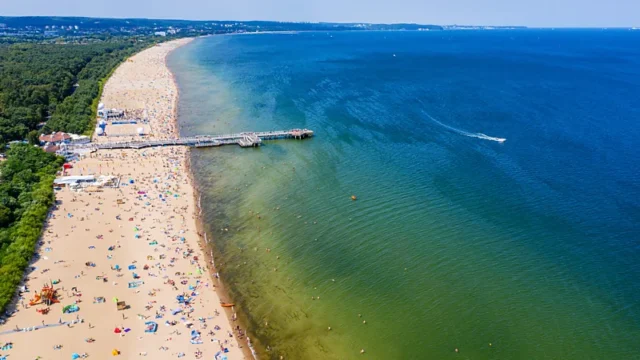Discover Velo Baltica: Poland’s Hidden Gem for Slow-Travel Biking
Introduction
Europe is celebrated for its cycling-friendly countries like the Netherlands, Belgium, and Denmark. Yet, Poland is emerging as an underdog leader in slow-travel biking, offering some of the most scenic and accessible cycling routes. The Velo Baltica, or R-10 trail, along Poland’s Baltic Coast is a prime example. This route spans over 230 kilometers of stunning coastline, taking cyclists through endless dunes, historic towns, and natural wonders. This article explores the charm of the Velo Baltica route, highlighting its attractions and why it should be on every cycling enthusiast’s bucket list.
Cycling Along Poland’s Baltic Coast
A Journey Through Diverse Landscapes
The Velo Baltica cycling route stretches from the border town of Świnoujście, adjacent to Germany, to the coastal town of Ustka. This journey along the West Pomeranian Voivodeship region showcases a variety of landscapes, including windswept dunes, romantic windmills, historic Hanseatic towns, and abandoned forts. Despite being less popular in winter, the route offers a unique charm year-round.
Historical and Natural Attractions
One of the highlights of the Velo Baltica is the blend of natural beauty and historical significance. Cyclists can explore the 19th-century Prussian coastal Gerhard Fort in Świnoujście and the labyrinthine Underground City, a complex of seven bunkers from the 1930s. The route also passes through Wolin National Park, home to a bison reserve and the highest coastal cliffs in Poland. Further along, the scenic ruins of a medieval Gothic church near Trzęsacz and the observation platform of the 45-meter-high Niechorze Lighthouse provide breathtaking views over the Baltic dunes.
My Cycling Experience on the Velo Baltica
Setting Out from Kołobrzeg
On my recent trip, I chose to cycle a 35-kilometer section from Kołobrzeg to Mielno. Kołobrzeg, a town that transforms into a bustling seaside resort in summer, is accessible via rapid Intercity trains from major cities like Warsaw, Krakow, and Poznan. The town’s attractions, including a long promenade, a 26-meter-high lighthouse, and the Gothic Cathedral Basilica, have been meticulously restored after World War II.

The Route and Its Facilities
The Velo Baltica is user-friendly, with a dedicated cycling lane, clear signage, and various facilities such as resting stations, self-service repair points, and tourist information desks. Accommodation options along the route cater to all budgets, making it easy to plan a trip. The best time to cycle is late spring when the Baltic nature is in full bloom, and there are fewer crowds on the beaches.
The Meditative Journey
From Kołobrzeg to Mielno
Cycling along the Velo Baltica offers a meditative experience, with the sound of the Baltic Sea setting a soothing rhythm. As I left Kołobrzeg, I crossed a wooden bridge over the protected Eastern Ekopark, known for its bogs and submerged trees. The bridge, rebuilt after being swept away by spring floods in 2010, stands as a reminder of the land’s fragility.

Continuing through the thick beech forest of the Ustronie Reserve, I encountered eerie ruins of 1950s artillery batteries and a control tower, abandoned in 1979. The paved trail then turned into a gravel road, leading me through meadows and the village of Gąski, where I climbed the 190 steps of an 1877 lighthouse to admire the coastal panorama.
Through Scenic Villages
The route then took me through the expansive Podczele dunes, a vast and often solitary stretch of the coast. In summer, this area hosts the Sunrise Festival, attracting renowned artists like Armin Van Buuren and Boris Brejcha. Nearby, Gdynia’s Open’er Festival is another major event on Poland’s Baltic coast.
I stopped for coffee on the pier in Sianożęty, a resort town with a charming wooden pier offering views of the local beaches. In high season, these beaches are dotted with colorful windbreaks, a tradition from the communist era that still persists today.
Reaching Mielno
The Final Stretch
Cycling from Gąski, the route briefly turned inland before returning to the coast in Sarbinowo. Here, I admired the 1856 Neo-Gothic Church of the Assumption of the Holy Virgin Mary, overlooking the beach promenade. Finally, I arrived in Mielno, a town combining 19th-century villas, Socialist-era resorts, and modern seaside hotels. Despite the winter season, Mielno was lively, with people enjoying sea views and long boardwalk strolls.

Conclusion
The Future of Slow-Travel Biking in Poland
The Velo Baltica route exemplifies Poland’s commitment to developing efficient, cycling-exclusive routes, making it a leader in slow-travel biking. This route is a dream for nature and history enthusiasts, offering freedom to explore at one’s own pace. Whether you’re cycling through scenic national parks, historic fortresses, or charming seaside towns, the Velo Baltica provides a unique and enriching experience.
Poland’s Baltic Coast, with its blend of natural beauty and historical depth, is an ideal destination for slow-travel biking. The Velo Baltica route, with its well-maintained paths, scenic views, and cultural landmarks, offers a cycling adventure that rivals the more famous routes of Europe. So, if you’re looking for a cycling trip that combines tranquility, history, and natural splendor, Poland’s Velo Baltica should be at the top of your list.
Embark on this journey and discover why Poland is an emerging star in the world of slow-travel biking.











